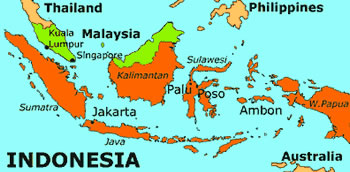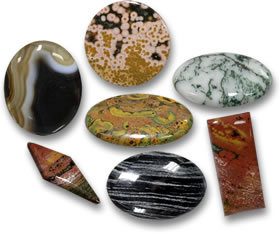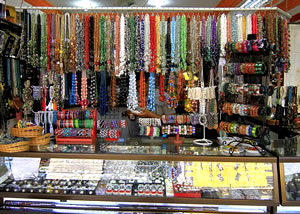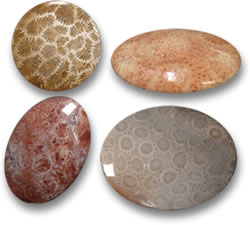|
Reviewed By Andreas Zabczyk
Indonesian Gemstones Map of Indonesia
Indonesia is an exotic Southeast Asian nation which is best known for thousands of beautiful volcanic islands and tropical beaches, including Komodo Island; the only place in the world which is home to the komodo dragon. Among the wonders of Indonesia are rainforests where orangutan roam and turquoise waters, under which are colorful coral reefs. Once part of the Dutch East-Indies, Indonesia has enjoyed independence since 1949. Its fertile volcanic earth and plentiful rain yield a vast variety of produce, such as pungent durian, rice, coffee and cocoa. Beneath the earth are mineral resources and gemstone deposits, which include chalcedony, chrysocolla, diamond, garnet, idocrase, jasper, nephrite, obsidian, opal, prehnite, sapphire and quartz. Some of these are recent discoveries and others have been mined for many years. Organic gems found in Indonesia include pearls, petrified wood and amber. The use of gemstones has a long history in Indonesia, as evidenced by the discovery of bracelet-like objects in West Java dating back to around 3500 BC. These ancient jasper jewelry items were found at Mount Padang, believed to be a man-made pyramid constructed during the Bronze Age and possibly the world's oldest man-made structure. The Indonesian gemstone industry is primarily located in South Kalimantan on the island of Borneo, the largest in Asia and shared among Brunei, Malaysia, and Indonesia. Borneo, once known as "Suvarnabhumi" by Indians, meaning "Golden Land," is rich in gold, silver, and platinum deposits, particularly in Kalimantan and Sumbawa. The largest gold mine is located in Papua's western province, with the eastern part belonging to Papua New Guinea.  Indonesian Jasper Cabochons
One of the most colorful stones found in Indonesia is jasper. It is an impure, opaque variety of quartz that can be found in almost any color, with stripes, spots or flamed patterns. Indonesian jasper cabochons are found in delicate neutral colors, eye-catching vivid colors, or dark masculine hues (see image, left). One bright yellow and black stone from Java is traded as "bumble bee jasper". However, this material is actually composed of volcanic lava and sediment, so is not jasper. The presence of sulfur gives it the vivid yellow colors. Another product of volcanic activity is obsidian; a volcanic glass. This is also found in Indonesia, especially mahogany obsidian, so-called because of its rich mahogany-colored streaks. It is often carved into cameos. The village of Cempaka, and other villages near Martapura in South Kalimantan are sources for Indonesian gemstones and good quality diamonds have been found in Kalimantan for many years. During colonial times, the Dutch mined diamonds in this region, though mining was carried out almost a thousand years before this. In the 1920s, the diamond trade focused on South Africa, and in the 1940s, the Japanese invaded Indonesia. The Japanese Navy vessel, Ashigara, bound for Singapore, sunk in the Java Sea in 1945 after coming under attack by allied submarines. It is said that the ship was loaded with gold and possibly gemstones. In 1965, a 167-carat diamond was found in South Kalimantan and named the "Tri Sakti", which refers to the "Three Principles" of Indonesia; the nation, the religion and unity. The diamond yielded a 50.53-ct emerald-cut gemstone. Additionally, a rare, 3.02-carat blue diamond was found in 2006, which was named "The Chelsea Blue" and a 200-carat diamond was unearthed in 2008.  Jewelry Shop in Martapura
The town of Martapura is referred to as "the City of Diamonds" and is a center for gemstone trade and processing. The gemstone market there operates on Tuesdays and Saturdays. Like several other Southeast Asian gemstone sources, the deposits of Indonesia are alluvial, meaning that the minerals are deposited by flowing water. Thus, the main method by which gemstone materials are recovered is by excavating gem-bearing gravel which is washed and sifted to separate the gems from the gravel. This is done by digging shafts, by burrowing into hillsides or by recovering gravel-containing earth from riverbeds. Naturally occurring pearls have been found in Indonesian waters for centuries, but these are exceedingly rare. The great demand for saltwater pearls makes farming pearls a worthwhile venture. Saltwater pearls, including Akoya, South Sea and Tahitian pearls, are cultured in Maluku Province; a group of islands in the southeast. There are also pearl farms in other areas, such as Sulawesi, Nusa Tenggara, Lampung and Papua. In fact, Indonesia is one of the world's most important producers of saltwater pearls, with a large share of the global market and a great deal of foreign investment in the industry, mainly from Japan and Australia. Another organic gemstone that is found in several parts of Indonesia, including Sumatra in Lampung Province, is amber. Amber is fossilized tree resin which is found in many regions of the world. Some of the amber from Indonesia is particularly interesting because rather than being completely golden in color, it exhibits blue fluorescence and is thus sold as "blue amber".  Indonesian Fossil Coral Gemstones
Agatized fossil coral is coral that has gradually been replaced by agate. This is not mined from the sea bed, where coral reefs are protected, but collected from the earth, where the ancient coral reefs have been thrust upward by tectonic activity. Fossil corals are found in Kalimantan, Sumatra and Java. They are sometimes kept as intact specimens, carved into ornaments or cut and polished into gemstone cabochons. Petrified wood is another example of a fossilized material found in Indonesia. Over the last decade or so, the domestic Indonesian gemstone industry has expanded. Some Indonesians believe in the metaphysical powers of gemstones and enjoy wearing healing stones, such as amethyst, agate, idocrase, nephrite and chrysocolla. A piece of jewelry containing chrysocolla was said to have been worn by President Susilo Bambang Yudhoyono and he apparently gave a chrysocolla stone (known as "bacan" in Indonesia) to former President Barak Obama during a visit, which further increased the popularity of colored stones in the country. In 2015, Indonesia was reported to have caught "gem fever", with gemstone jewelry being widely worn. Indonesian gemstones are also sold to tourists as souvenirs, in Bali and Java, as well as being exported, where they are traded all over the world. The center for gemstone processing and trade is in the capital, Jakarta. Indonesia's gemstones are as diverse and colorful as the culture, flora and fauna that thrive in the equatorial archipelago. This Page in Other Languages
|
| STAY IN TOUCH | NEWSLETTER |
| *You're signing up to receive GemSelect promotional email. |
Copyright © 2005-2024 GemSelect.com all rights reserved.
Reproduction (text or graphics) without the express written consent of GemSelect.com (SETT Company Ltd.) is strictly prohibited.
2784